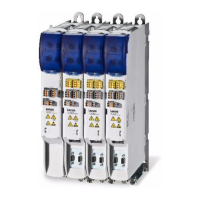5 Motor control & motor settings
5.4 Manual control
69
Lenze · i700 servo inverter · reference manual · DMS 3.0 EN · 06/2016 · TD06
_ _ _ _ _ _ _ _ _ _ _ _ _ _ _ _ _ _ _ _ _ _ _ _ _ _ _ _ _ _ _ _ _ _ _ _ _ _ _ _ _ _ _ _ _ _ _ _ _ _ _ _ _ _ _ _ _ _ _ _ _ _ _ _
5.4 Manual control
As an alternative wiring check, the "Manual control" mode can be activated.
Functional description
The "manual control" modes enables manual operation of the i700 servo inverter via the
Engineering tools »EASY Starter« and »PLC Designer«.
• In the manual control mode both the current and the frequency are run to the set final value via
a parameterisable ramp time. The ramp times constitute the time span during which the
respective parameter is run from zero to the final value.
• In the manual control mode holding brakes, if any, are automatically released. Holding brake
control ( 160)
Note!
Controlled synchronous motors (SM) can only be traversed under various restrictions:
Restriction 1:
The speed variation per control cycle may only be very minor.
• Either make minor changes/leaps of the "Manual jog: Frequency" parameter or select
the "Manual jog: Ramp time - frequency" very high.
Restriction 2:
The "Manual jog: Frequency" parameter must be so low that the voltage
range is not left or that the field weakening range is not reached.
• Provide a reserve of approximately 20 % towards the voltage limit. The voltage
requirement is proportional to the speed and thus proportional to the frequency; the
voltage limit is determined by the DC-bus voltage.
• For 400-V motors in combination with a 400-V mains, "voltage range" roughly
describes the range below the rated motor speed.
Restriction 3:
The "Manual jog: Setpoint current" parameter must be selected so high
that the friction and load torques of the machine at final speed (= proportional to the
parameter "Manual jog: Frequency") can be overcome.
In case of devices that correspond to the "Dual Use Regulation" (EC 428/2009), values of
+ 599 Hz to + 1000 Hz or - 599 Hz to - 1000 Hz do not cause an increase of the output
frequency. Please observe the dead band that occurs in this case.
More information can be found in the section entitled Frequency and speed limitations
( 155)
.

